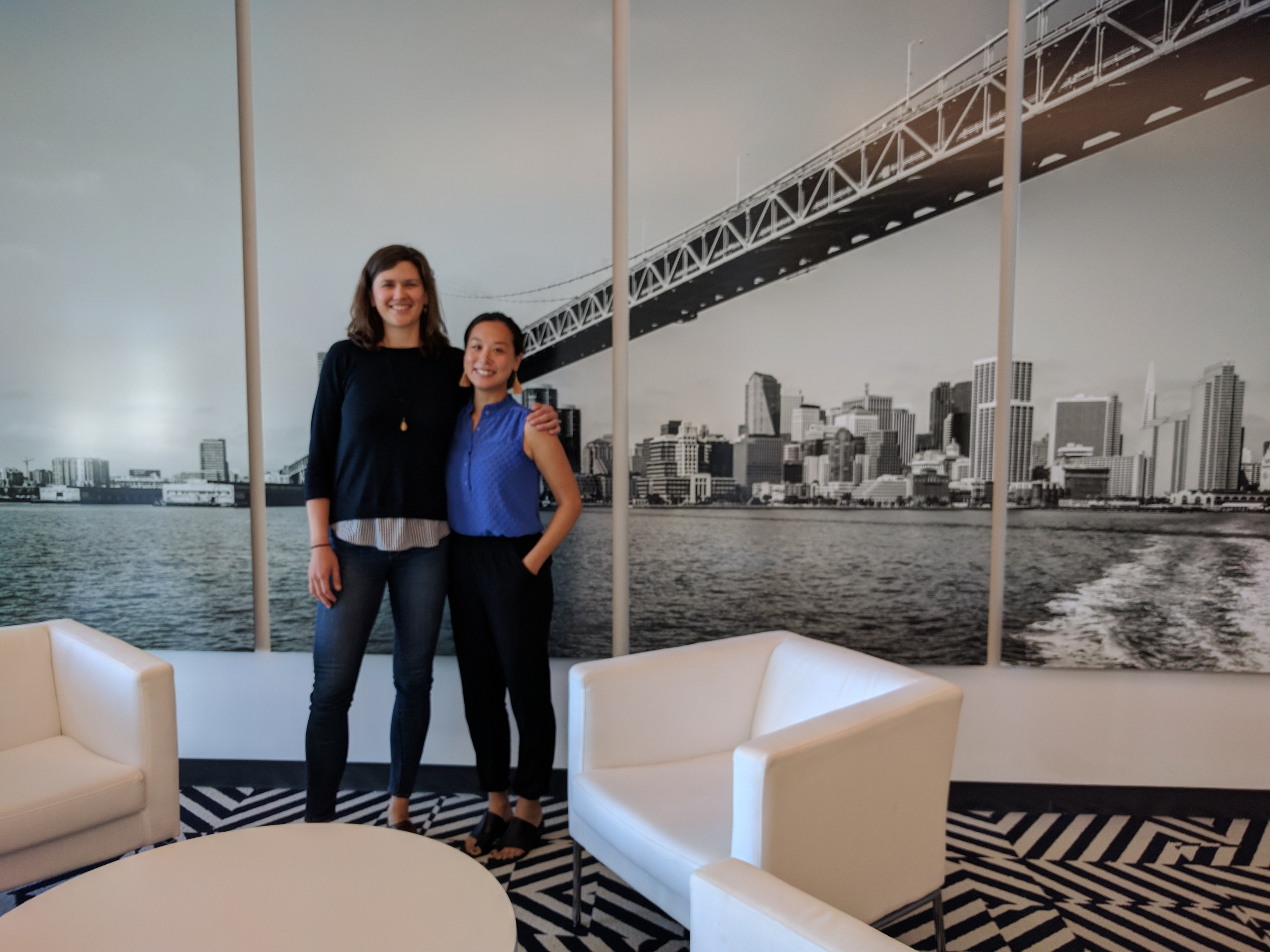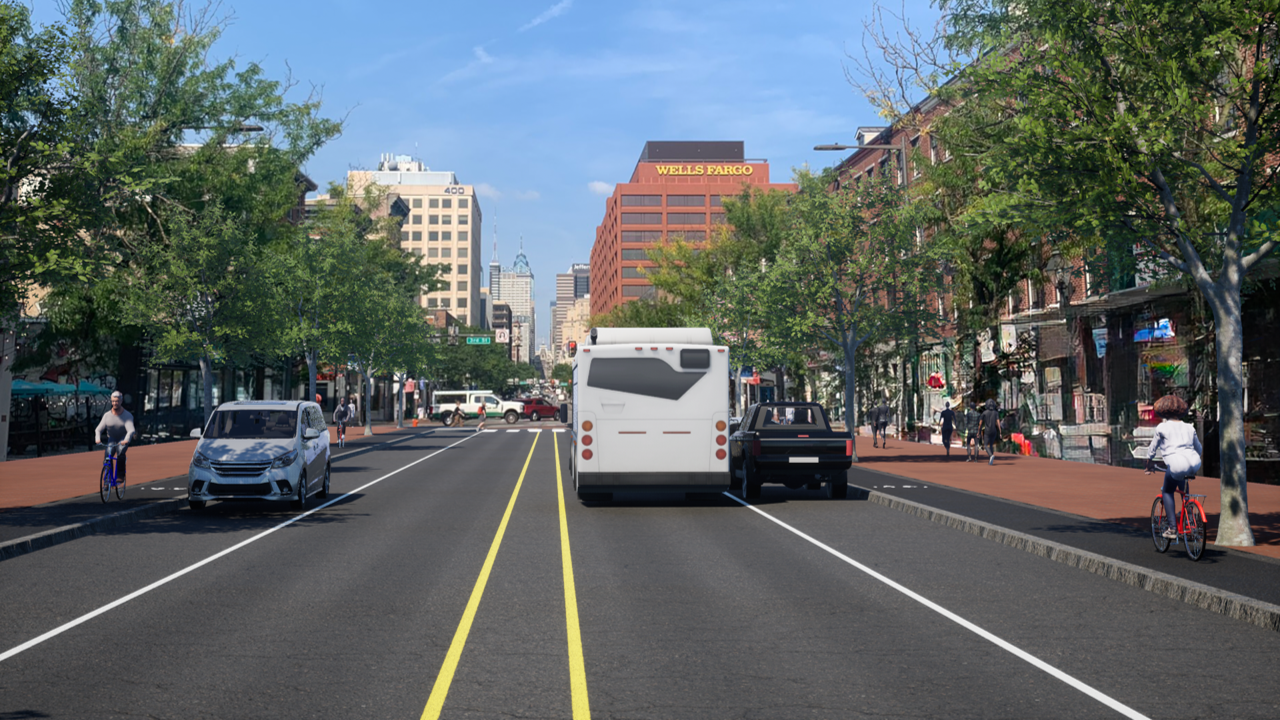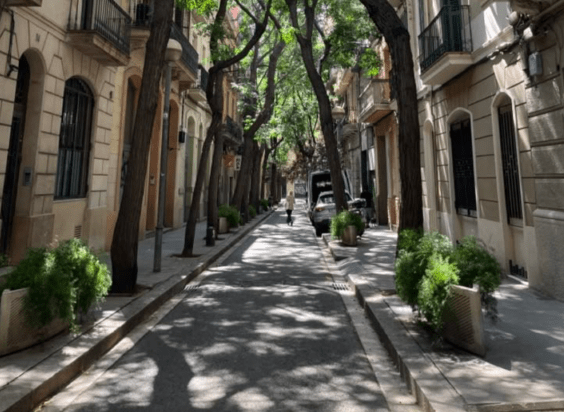Note: GJEL Accident Attorneys regularly sponsors coverage on Streetsblog San Francisco and Streetsblog California. Unless noted in the story, GJEL Accident Attorneys is not consulted for the content or editorial direction of the sponsored content.
By one study, as few as 15 percent of transportation workers, planners, managers, etc. are women. This, many argue, translates into infrastructure designs and transit planning that doesn't adequately consider the needs of women and families. Enter TransitCenter, the New York-based foundation, which launched its Women Changing Transportation mentorship program in February. According to the Center's website, they developed the program "...to create connections and provide support for reform-minded women in the industry who are committed to making transit more effective and equitable."
How's it going so far? Streetsblog sat down with three Northern California participants in the program: Terra Curtis, Senior Associate, Emerging Mobility Co-Lead at NelsonNygaard, Amar Azucena Cid, a transportation planner for the California Department of Transportation within the Division of Rail and Mass Transportation, and Tiffany Chu, Co-founder and COO of Remix to find out.
***
Streetsblog: Tell me what event in your life got you into this field—if it was a single event?
Amar Azucena Cid: I’ve always been pretty interested in how people move. I was raised in a community that was considered disadvantaged, poor, ghetto--we didn’t have access to places. And at a very early age I saw there was a lot of traffic through our street, speeding, like on a highway.
SB: Where was this?
AAC: Oak Park, Sacramento. That's the first suburb of Sacramento and the highway cut off most of the business district from our community in the 1960s, so it became disadvantaged. I remember in elementary school writing to our city council people to try and get the cars to slow down. I asked for speed bumps because other communities have them. I asked for a bus stop. It's important that kids can play in the street, get on the bus and have a safe space. That was my earliest memory in helping people move and be safe.
SB: Then what?
AAC: I went to college at Davis, studied housing and health practices. Then I went back East for grad school, to Clark University west of Boston. I studied all about how people move, how they have food, do they have healthcare, what are transportation policies and how does that look in different communities and countries.
SB: You looked at the intersections of these realms at Clark?
AAC: They’re pretty well known for geography. I studied from Susan Hanson, a professor who does some great work looking at feminism, women's rights, and transportation.
SB: Then you came back to Sacramento?
AAC: When I moved back I started working at the Capitol for an Assemblymember. I saw that Caltrans has a division of transit and does mass transit, so I got into the division of rail and mass transit for the last ten years.
SB: So you work in rail? On Amtrak and the Capitol Corridor?
AAC: We have rail and mass transportation, have people working with the Joint Power Authorities, working with the corridors, but I work with the low-carbon transit operations program.
SB: Cap-and-trade?
AAC: It's been re-branded to the California Climate Investment, and this program funds transit projects throughout the state that reduce Greenhouse Gas Emissions. They also prioritize funding for low income and disadvantaged communities.
SB: So you're doing exactly what you set out to do. Terra, what about you?
Terra Curtis: I grew up in Maine in a medium-to-large-size city for Maine Standards.
SB: Which is small by California standards presumably.
TC: Bangor has 35,00 people, and I grew up riding all sorts of wheeled, people-powered machines to get around visiting friends, going to the corner store, stuff like that. I rode my bike, had a kick-scooter, had a Big Wheels. Then I left the small town to go to college in Boston and as soon as I got there I started relying on public transit a lot more. And walking.
SB: So no more bike?
TC: One of my good friends got one and said 'remember when we were kids and used our bikes to get around?' And I got a used bike on Craig's List and started using it to de-stress.
SB: But not for transportation?
TC: No, it wasn't a transportation thing. We went out in the evenings and explored areas of the city I hadn’t seen before. When I graduated from college I had a few friends who got their degree, got a job, and got a car--to become an 'adult.' But I was always skeptical. I’ve been doing fine without a car. Why should that be the next step in life? And I didn't.
SB: So back to transit?
TC: No, that's when I started heavily riding my bike to get around. That was my light-bulb moment. I studied math and after undergrad worked in economics, and after a few years made my way out West and settled in San Francisco.
SB: And that brought it together for you?
TC: I started getting involved and interested in how decisions around my neighborhood were being made. I started participating in the San Francisco Bicycle Coalition.
SB: And that moved you towards transportation policy. Where did you live?
TC: The Mission, since 2007, and I started to understand that this is a profession and it was something that aligned my background in being an analytical person, but also really married my desire to relate that to people and worldly outcomes. It all seemed to coalesce around that time.
SB: So math, bicycles, people--
TC: I went back to grad school to study planning at Chapel Hill. I was really interested in bicycles. I married an entrepreneur. I found myself comparing the way things are done in that industry versus the way things are done in planning. I continue to have a curiosity to explore the ways we can learn from each other.
SB: Tiffany, what's your story and entry into the profession?
Tiffany Chu: I grew up in suburban New Jersey at the end of a cul-de-sac. It was the American Dream for immigrant parents. But there was also a distinct lack of freedom if you didn't drive a car.
SB: And you found freedom without a car where?
Chu: Going to school in Boston at MIT and riding the 'T'--I studied architecture and then I found my way into urban planning.
SB: It seems Boston head a heavy influence on all of you.
TC: I was there from 2001 to 2005. Boston was not friendly for bikes. I remember being on a bike lane on Mass Ave--and that was the whole 'network.'
Chu: And I remember a bunch of classmates got doored.
AAC: There was no bike access, no support for biking.
SB: On to the intersection of women and transportation. A few years ago we did a study and discovered that even Streetsblog's own readership skews heavily male. Studies show transportation workers are disproportionately male. Why is this still so in our field?
TC: I have a skewed perspective. In several of my projects, the leadership is women. I have taken that for granted. We’ve got a project going on that's being led by three people, and they're women. The staff people are men.
SB: So your experience seems to buck the trend. Still, you must have seen this in the larger realm of transportation?
TC: On the intersection of women and transportation, I think it was blind to me until I had a child. As I'm going into my identity as a mother and taking my child around the city and the world, I'm developing more sensitivity for her safety. It feels like a biological...
SB: A biological imperative?
TC: Like I’m hyper-aware in the ways in which we’ve failed in providing a sense of comfort and safety for children. A lot of this experience is through biking with her, which we do a lot.
SB: It's scary riding with your daughter?
TC: No, my primary experience is quite joyful. I love taking her out there. She smiles, she points at things that I don’t even notice. But I will wake up in the night and have a terrible image of something happening because of her vulnerabilities.
SB: So our unsafe infrastructure gives you nightmares. That's a statement. Tiffany, you cycle in San Francisco too? Do you have similar impressions?
Chu: My first experience biking in San Francisco was in the summer of 2008, when I was here interning and I had just come back from studying abroad in Copenhagen. There was cultural whiplash. Everyone else on the road at that time was a spandex-clad cyclist. There’s a history of advocacy and bike culture around performance, as opposed to getting from A to B.
SB: But that's changed.
Chu: I found when I started cycling most of my girlfriends and peers, who were not studying urban planning, it was seen as a dangerous, outlier thing. But I think there’s an ongoing stigma of it being for brave people. And there’s a strong correlation of being brave and male. I'm a small Asian woman, so I think most things are bigger than me and scarier. I'm seeing more mothers out there. Seeing cyclist carrying trailers, with puppies and babies. They're also all smaller than me. You see safety by people you correlate with.
SB: And do you correlate with people in your profession?
Chu: At Remix we have lots of women in leadership positions. It’s really important to me as a founder, so I’ve been proud of that. But when I go out to conferences to represent Remix, it’ll happen at least one to four times per conference.
SB: What happens?
Chu: I’ll be talking to one senior exec at a government agency or some other firm, and they start to ask me about who I am, and there’s always an assumption that I’m a junior person on the staff, as opposed to the founder. If I introduce myself as a founder there’s a pause.
SB: Amar, what's your experience?
AAC: There are quite a few women in leadership roles at Caltrans who I work with and support. But on the outside, working with outside folks... I manage a program and that gets a kind of shock.
SB: How so?
AAC: People ask "where is your boss, is he around?"
SB: Oy.
AAC: And I’m like, "no I actually manage this program." Sometimes they’ll talk to my male staffer before they acknowledge that I’m even standing there. My staff will say: "This is my boss, maybe you should ask her." There have been quite a few folks who even after introductions, they only address my male staff.
SB: Do you get that from women too?
AAC: I don’t know if it’s ignorance, but yes, women do it also. Some women only seek a response from a male counterpart.
SB: Of course that's terrible on its own. But how does this translate into bad policy?
TC: If we look historically at transportation there's a focus on the automobile... there was intense excitement about this technological advance and the possibilities, but people forgot about the other impacts that it would have on the built environment. The field of transportation was extremely dominated by men at that point.
SB: So you think the historical dominance of the automobile in the transportation picture is somehow related to males dominating the field?
TC: I don’t know if it’s completely the fault of them being men, but I think it was more echo-chamber-y than it is now. I think there was less awareness of the externalities that would be caused by that approach.
SB: Amar?
AAC: I agree with Terra. The automobile industry was predominantly male, and who are they building this automobile for? Who are they building the systems for it? ...what does that look like for women, specifically mothers and children?
SB: Tiffany?
Chu: Recent initiatives around designing facilities that are suitable for “all ages and abilities” shows what was built before was not designed for all ages and abilities. It’s very common for transit agencies to have staff go and ride transit, and have their board ride transit for a day, but rarer for an entire transportation department to have all the engineers and leadership on bikes to bike the whole system.
SB: Do you have a specific sense about where that results in mistakes?
Chu: It's even down to the people manufacturing the signage.
SB: Right. I've written about this. Signs are often placed way too high for anyone on a bike. It's as if they're positioned by tall people in big cars only.
Chu: Is that person in the shoes of the people using the facility? It’s all down to user-centered design. In tech they call it “dogfooding.”
SB: Dogfood?
Chu: You need the people who are building the app using the app themselves.
SB: Right, I'm reminded of a story we did about new bridges in Oakland that Caltrans officials though were safe to bike on, but it's obvious nobody who designed them would ever ride them with their child, as you do in San Francisco, Terra. That said, the MTC Clipper Commission recently voted to punt a study about fare integration. I forget the exact gender composition of the board, but BART's Grace Crunican helped lead that, much to the disappointment of advocates. I remember thinking to myself, well, diversity is a worthy goal in its own right, but it won't help the transit-riding public if we get diverse people in leadership positions who are just as parochial as the people they replaced. Any thoughts on that?
TC: Women are not perfect. I don't know that you should point at her for being a woman. What you're pointing to is a need to have more diverse voices in general, because any one individual is going to have their biases. The only solution is to bring in multiple perspectives and voices.
Chu: I was just listening to a podcast about this issue. There’s more at stake for a woman in making the kind of decisions that are perceived as too radical, or too heavy-handed. Then they’re seen as not-collaborative. Whereas a man would be labeled as visionary.
SB: Grace was retiring. I'm not sure what she had at stake at that particular meeting.
Chu: I'm not directly relating this to Grace, but I think there’s more at stake for women to make bold decisions because of how they’re perceived in the context of all the other decisions they need to make.
TC: I don’t really have a lot to add to that. But I will bring up the example of L.A. They have such a bold leader in Seleta Reynolds. Women leaders have so much at stake, because of that risk taken just by being a woman.
SB: Speaking of bold, women leaders, do you have someone in mind to lead SFMTA? Gender aside, or not, what characteristics would you look for?
TC: Someone who inspires a broad-base of people. Someone very public-facing, very visible. I think there are great people at the agency right now. With an inspirational leader, their capabilities and skills could be brought to life.
SB: Someone like Janette Sadik-Khan?
Chu: Someone who moves fast, as Janette could.
AAC: I think at any of our larger transit agencies, it would be great to have somebody who is not afraid to push and move faster. I work for the state, so it’s a little more difficult ... there’s a lot of chain of command and vetting that we must go through, but having management or leadership that has come up through the ranks… and would be invested in transit and access for all, not just someone who is making a career move. Someone who actually rides the bus or is super excited about light rail and expansion and frequency increases … somebody who knows it and is personally invested.
For more information on the fellowship program, and how to connect with transportation professionals, check out the web page or look them up on Facebook.






